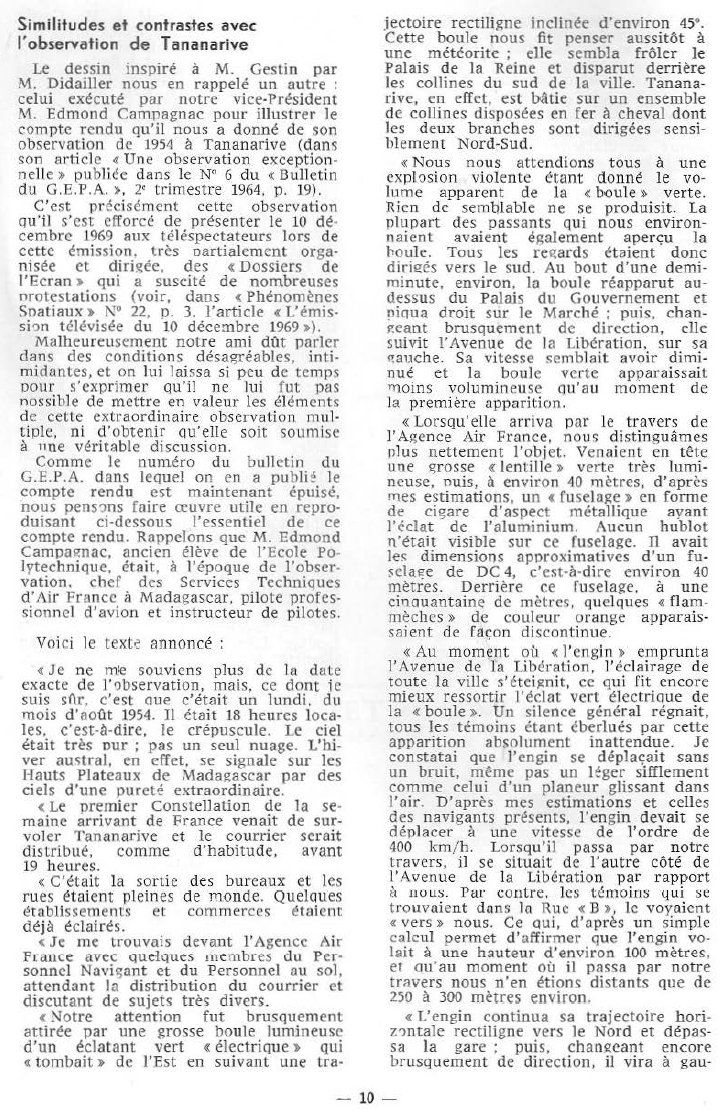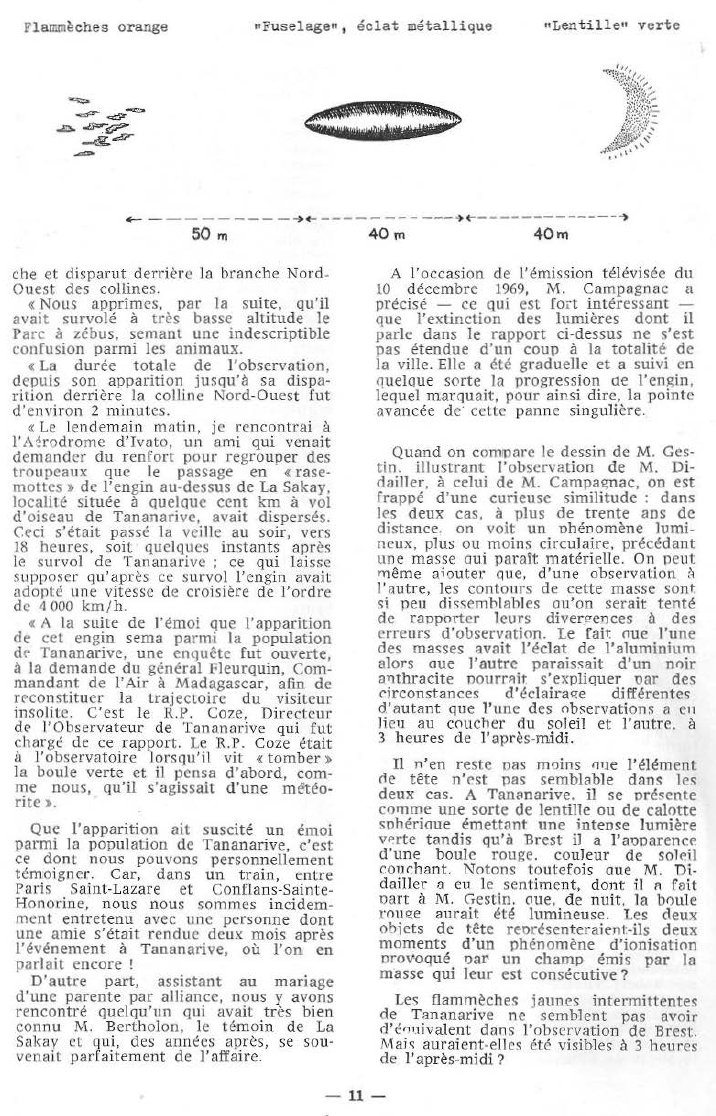
|
The sketch inspired for Mr. Gestin by Mr. Didailler reminds us of another one: that executed by our vice-president Mr. Edmond Campagnac to illustrate the report he gave us of his 1954 observation in Antananarivo (in his article "An exceptional observation" published in #6 of the "Bulletin du GEPA", 2nd quarter 1964, p. 19).
It is precisely this observation that he endeavored to present to viewers on December 10, 1969 during that TV show, very partially organized and directed, "Les Dossiers de l'Ecran", which provoked numerous protests. (see, in "Phénomènes Spatiaux", #22, p. 3, the article "The television broadcast of December 10, 1969"). Unfortunately our friend had to speak in unpleasant, intimidating conditions, and he was given so little time to express himself that it was not possible for him to highlight the elements of this extraordinary multiple observation, nor to obtain that it would be subject of a real discussion.
As the G.E.P.A. bulletin in which the report was published is now out of print, we believe that we are doing useful work by reproducing most of this report below. Recall that Mr. Edmond Campagnac, a former student of the Ecole Polytechnique, was, at the time of the observation. Head of Air France Technical Services in Madagascar, professional airplane pilot and pilot instructor.
Here is this text:
"I can't remember the exact date of the sighting, but what I am sure is that it was a Monday in August 1954. It was 6 p.m. local time, that is to say, twilight. The sky was very pure; not a single cloud. The southern winter, indeed, is remarkable on the Highlands of Madagascar by skies of an extraordinary purity.
"The first Constellation of the week arriving from France had just flown over Tananarive and the mail would be delivered, as usual, before 7 p.m.
"It was the exit from the offices and the streets were full of people. A few establishments and businesses were already lit up.
"I was in front of the Air France Agency with a few members of the Flight and Ground Staff, waiting for mail to be delivered and discussing a wide variety of topics.
"Our attention was suddenly drawn by a large luminous ball of a brilliant electric green, which "fell" from the East following a rectilinear trajectory inclined by about 45°. This ball immediately made us think of a meteorite; it seemed to brush against the Queen's Palace and disappeared behind the hills to the south of the city. Tananarive, in fact, is built on a set of hills arranged in a horseshoe shape, the two branches of which are directed more or less north-south.
"We were all expecting a violent explosion given the apparent volume of the green 'ball'. Nothing like that happened. Most of the passers-by around us had also seen the ball. All eyes were, therefore, headed south. After about half a minute, the ball reappeared above the Government Palace and hovered straight over the Market; then, suddenly changing direction, it followed the Avenue de la Liberation, on its left. Its speed seemed to have decreased and the green ball appeared less bulky than when it first appeared.
"When it came across of the Air France Agency, we could make out the object more clearly. A large "lens" came in front, very bright green. Then, at about 40 meters, according to my estimates, a "fuselage", cigar-shaped, metallic in appearance with the shine of aluminum. No porthole was visible on this fuselage. It had the approximate dimensions of a DC-4 fuselage, that is to say, about 40 meters. Behind this fuselage, at about fifty meters, a few "sparks" of orange color appeared discontinuously.
"As the 'craft' moved down Avenue de la Libération, the lighting throughout the city went out, making the electric green glow of the 'ball' even more visible. General silence reigned, all the witnesses being dumbfounded by this absolutely unexpected appearance. I noticed that the craft moved without a sound, not even a slight whistle like that of a glider sliding in the air. According to my estimations and those of the navigators present, the craft had to move at a speed of the order of 400 km per h. When it passed at our level, it was located on the other side of the Avenue de la Liberation in relation to us. However, the witnesses who were in the Street "B", saw it "towards" us. Which, according to a simple calculation makes it possible to affirm that the craft was flying at a height of approximately 100 meters, and when it passed across us we were only about 250 to 300 meters away.
"The machine continued its straight horizontal trajectory towards the north and passed the railway station; then, again suddenly changing direction, it veered to the left-
- 10 -

|
and disappeared behind the Northwest branch of the hills.
"We later learned that it had flown over the Zebus Park at a very low altitude, causing indescribable confusion among the animals.
"The total duration of the sighting, from its appearance until its disappearance behind the Northwest hill was approximately 2 minutes.
"The next morning, I met at the Ivato airfield, a friend who had come to ask for reinforcements to regroup the herds that the craft passed over "La Sakay", a locality located some hundred km in straight line from Antananarivo, had dispersed.This had happened the evening before, around 6 p.m., a few moments after the flight over Tananarive; which let us suppose that the craft had adopted a cruising speed of around 4,000 km per h.
"Following the rucus that the appearance of this craft caused among the population of Tananarive, an investigation was opened, at the request of General Fleurquin, Air Commander in Madagascar, in order to reconstruct the trajectory of the unusual visitor. It was Reverand Father Coze, Director of the Observatory of Tananarive who was in charge of this report. Father Coze was at the observatory when he saw the green ball "fall" and he thought at first, like us, that it was a meteorite."
That the apparition aroused a stir among the population of Antananarivo is something I can personally attest to. Because, in a train between Paris Saint-Lazare and Conflans-Sainte-Honorine, we incidentally spoke with a person whose friend had gone two months after the event in Tananarive, where people were still talking about it!
Also, attending the wedding of a relative, we met there someone who had known Mr. Bertholon, the witness of La Sakay very well and who, years later, remembered perfectly the case.
On the occasion of the television program of December 10, 1969, Mr. Campagnac specified - which is very interesting - that the extinction of the lights of which he speaks in the above report did not extend suddenly to the whole city. It was gradual and in a way it followed the progression of the craft, which marked, so to speak, the advanced spot of this weird power failure.
When we compare the sketch of Mr. Gestin, illustrating the observation of Mr. Didailler, with that of Mr. Campagnac, we are struck by a curious similarity: in the two cases, more than thirty years apart, we see a luminous phenomenon, more or less circular, preceding a mass which appears material. One can even add that, from one observation to another, the contours of this mass are so little dissimilar that one would be tempted to relate their divergences to observation errors. The fact that one of the masses had the shine of aluminum while the other appeared an anthracite black could be explained by different lighting circumstances, especially since one of the observations took place at sunset and the other at 3 in the afternoon.
The fact remains that the head element is not similar in the two cases. In Tananarive, it appeared as a sort of lens or spherical cap emitting an intense green light, while in Brest it has the appearance of a red ball, the color of the setting sun. Note, however, that Mr. Didailler had the feeling, which he told Mr. Gestin, that, at night, the red ball would have been luminous. Would the two head objects represent two moments of an ionization phenomenon caused by a field emitted by the mass which is consecutive to them?
The intermittent yellow sparks of Tananarive do not seem to have an equivalent in the observation of Brest. But would they have been visible at 3 o'clock in the afternoon?
- 11 -
[The article continues with thanks to Pierre Gestin who collected the report of Brest and to Mr. Didailler, its witness. It continues with other cases in France, unrelated to the Tananarive sighting.]
Reference of this source: